Chemistry gamedev or how to manipulate players
After the release of my first mobile toy, I actively began to engage in self-education in the field of game design to improve my product. I came across a curious article in the bourgeoisie that made me take a different look at the games and gave a more complete understanding of the development process. I rarely manage to come across something really worthwhile, but I liked the text so much that I decided to make a Russian translation. Among other things, I threw out all the lyrics, the author's attempt to joke and some water.

Recently, I came across a description of alchemy, that magic pseudoscience of the past millennium, which evolved into modern chemistry. For a moment, I thought that the authors seemed to describe the current situation in the field of game design.
')
Every time I rub into perfect creations like Tetris or Mario, I see traces of a certain structure behind the gameplay. I believe that a mechanical and predictable heart, built on the basis of human psychology, beats at the center of every successful game.
But what if we decoded these systems and turned them into a practical method for creating games?
In an attempt to define games, attention was focused on the mechanical elements of the game — primitive actions that the system allows the player to perform. Such an approach makes it necessary to treat games as autonomous logical systems.
Mechanics and aesthetics are undoubtedly important parts of game design, but not only this makes the game enjoyable. A set of unrelated elements is often obtained that say nothing about the important side of the interaction between the game, as a stimulus, and the player, as an active and developing participant.
Games are not mathematical systems. These are systems that always include an energetic person, full of desires and emotions, which is the core of the system. To accurately describe the game, you need a working psychological model of the player.
Our player model is extremely simple - this is a subject who starts to act, consciously or subconsciously, in order to learn new skills to the maximum for their benefit. He gets pleasure from successfully acquired skills.
Three key player model concepts:

Skill
A skill is the knowledge that a player uses to control the game world. Some skills are based on concepts - the ability to control the map, while others are very physical - knocking on a nail with a hammer.
Learning motivation
The game is instinctive. In modern conditions, when we do not actively perform actions related to food and shelter, people begin to play by default. Stronger mechanisms in the form of boredom or disappointment are pushing for action. With a free minute, children rush into the game with cubes or dolls, and adults have more complicated hobbies. This suggests the need to encourage people, because solitary confinement is still one of the toughest sentences for hardened criminals.
The flip side of the coin - we want a tuition reward. Surprisingly, the fun term “fun” occurs in the process of mastering knowledge, skills and tools. When you learn something new or understand something so well that you can use this knowledge for your own purposes, you experience joy.
When we learn something new, the natural opiates endomorphins, chemically similar to the structure of morphine, are released. We are constantly tuned to the desire to receive new information. What you and I call curiosity can be interpreted as the fact that our brain is looking for its next dose.
As game designers, we now and then deal with the emotions of fun, boredom and frustration. It is pleasant to recognize that these conditions are biological phenomena, and not some kind of mysticism.
Benefit perception
Players wish to gain skills that will be beneficial in the game. Perhaps the game is a deeply pragmatic activity. Our impulses to take part in games are instinctive due to evolution, because it can help improve our lives, without the threat to life or possible failure. We play because we are set to expect a possible result from our seemingly useless actions. We stop playing when we can't find anything useful.
Awareness of profit is more important than objective measurement of value. People are not logical creatures. We know that people have strong beliefs on how they weigh their actions. For example, they often take unreasonable risks because they are not able to correctly assess real odds. People have substantial limitations, depending on how much information they can take into account when making any decisions. Many decisions are made on the basis of highly predictable reactions of the sixth sense, which have their own subconscious rules.
The main components of the game are well described in various books, which pass from hand to hand from designer to designer during the last one to two decades. Each block describes how a player gains a new skill.
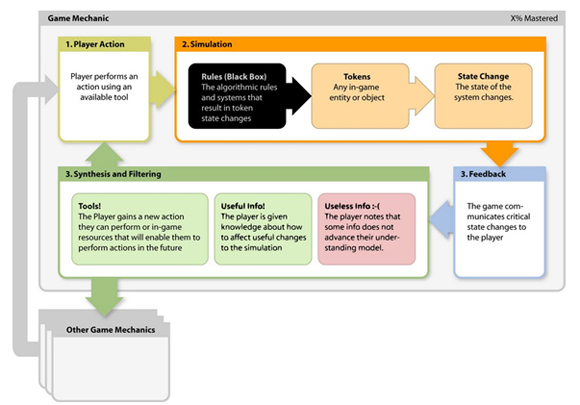

How the model works in Mario:

The first entry can only give the key to understanding. Something happened and did not arouse much interest. The user then presses the button again to test his theory, and Mario flies up into the air again. At this stage, the player smiles, because he understands that he has acquired an interesting skill that can be used in the future.
What we call a game
Having acquired an interesting new skill, the players began to experiment with it. They check it in different situations to see if it is good. An interesting situation can be observed when a new player practices jumps, he almost immediately starts to jump happily when the level rises. At first glance, this is a silly frivolous activity. In fact, we are witnessing a human instinctive learning process in action.
During the game, the player will sometimes come across something where you can get interesting information that may lead to the acquisition of a new skill. At this point, it becomes noticeable that the player’s behavior is becoming more and more conscious. A mental model merge will begin to occur in his mind. In our example of jumping, the player hits the platform and can climb to the very top.
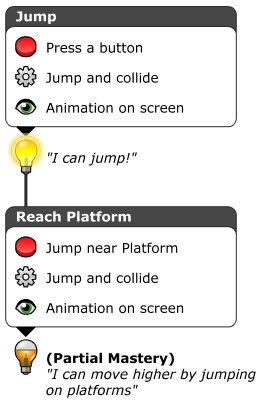
In most cases, to achieve mastery, you need to work out a new skill over time. In the end, the player uses the existing skill to acquire another skill. He chokes with pleasure and starts the process again and again.
Game mechanic connections
One skill is a component of a skill set. By linking more and more skills, you build a network that describes the entire game. Every expected skill, every successful action, every predicted outcome of stimulation, every bit of necessary feedback can be included in a simple but functional image.

Tetris game mechanic full-length connections
A skill chain can be used to simulate any game that you can imagine. Your project can be broken into dozens of simple elements connected together to form an easily readable game map. Communication elements in a single network allows you to make the mechanics of the game more deep and rich.
The process of interaction of players with the chain of skills
Players will travel from element to element, as Pac-Man runs along the track swallowing everything in its path until it reaches its goal. They move from one skill to another, even if they have only a vague idea of the ultimate goal. Getting to the end is their goal.
At this point, one of our purely human limitations comes into play. Players are not able to predict the value of a new skill beyond a pair of items in the chain. As long as there is a perceived new skill on the horizon with potential value, players will chase after it. Experience is the only thing that can be endless pleasure. As long as there are short-term rewards in a short amount of time, we continue to think that there will be some final prize for our efforts.
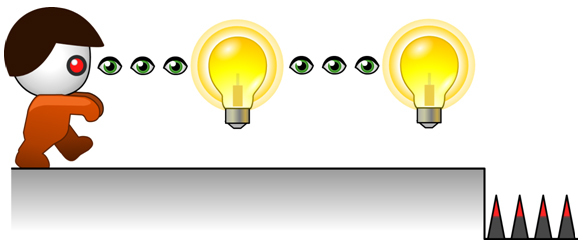
The skill chain provides enough useful information about the player’s state while he is busy playing the game. Imagine that a skill chain is a dashboard that lights up as soon as a player succeeds. At any time you can see the following information:
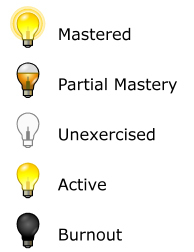
We talked a little about the mastered and partially mastered skills. New skills speak for themselves. If the player cannot perform the actions necessary to understand the skill, the skill will never be used or mastered. Mastery goes down the chain. If players are blocked early, they will never go further.
Active skills
The player experiences the joy of attaining mastery only once. Perfect mastery of the skill breaks the biological connection and dulls the pleasure obtained in the process of its use. It used to cling, and now you do not pay any attention to it.
Players have tremendous patience. They are ready to train their mastered skills before losing the pulse, in order to achieve the highest mastery. Players jump Mario countless times to make jump-related skills also stronger.
Combustion
Players do not always build connections between skills. They master a new skill, they play with it, but cannot find an interesting use for it. This is called combustion.
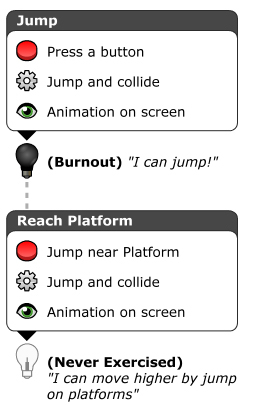
Suppose our player hit the jump button. He made the jump, and we assigned his skill a certain level. However, it is this player who will never understand what is the use of this action. Perhaps he did not jump near the platform and did not get a new experience. After a short period of experimentation without any interesting results, the player stopped pressing the jump button altogether.
When a player burns in a link in a chain, the consequences are reflected both from above and below.
Early stage of combustion
In the example above, the ability to “get to the platform” will never be mastered. The jump was not mastered properly. In a tightly bonded chain, early combustion can shut off a huge area of potential gaming experience.
Late stage of combustion
On the other hand, late-stage combustion in a skill chain may devalue active skills.
For example, we have a platform on which to jump, but there is nothing useful for the player on it. The player jumps to the platform, finds nothing interesting and soon stops jumping on the platforms at all. As a result, he jumps atrophy. If a player does not need to jump on platforms, then why should he jump at all?
Combustion - the best test assistant!
Combustion is a very powerful signal that our game is not able to hold the attention of players. We can understand at what point on which skill the combustion takes place. If you monitor the combustion along with other states of skills, you can accurately determine the problem areas of the game.

We considered the main elements of the skill chain and can now put it into practice. But there is something else that would be nice to learn.
Previously existing skills
Each player comes to the game with their own set of skills. These skills always form the initial nodes of the skill chain. The exact prediction of this skill set has a great effect on the player’s enjoyment of the rest of the game.
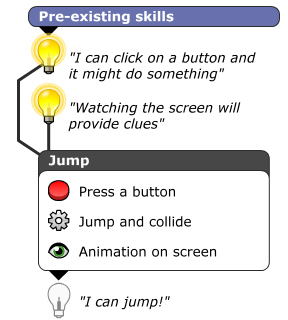
Lack of necessary skills
If a player lacks the skills expected from him, he will not be able to use the basic skills in our game. In our example with jumps, imagine a player who did not understand that you need to press a button on a joystick in order to do something. Such an example may seem ridiculous, but many non-gamers encounter this when they encounter a monstrously sophisticated modern controller. Many game designs automatically assume the ability to navigate in 3D space with the help of two awkward little roundels similar to each other and a lot of obscure buttons. Users who do not have this skill, succumb to despair, not seeing the vast amount of content.
It is important to understand that such users are not stupid. They just have a different starting skill bag. One of the key tasks of a game designer is to make sure that the people who play our game are able to master the most basic skills in the game. Ultimately, this means that you need to make an accurate list of already existing skills for the target audience and structure our early experience around these skills. Do not take into account the skills that can not be used there.
Hazards of basic skills
The flip side of all this is that if the players have already mastered the existing skills, the process of mastering the first links of the chain will be quite boring. A gamer who is overwhelmed is bored when a 10 minute control instruction is slipped to him. The rewards are worthless because his tormented brain does not react where it should be. If the game from the very beginning does not teach the player anything new, most likely it will be burned at an early stage.
For balance you need to focus on the right set of existing skills. If you choose everything correctly, it will end up playing “intuitively”, which players like very much. If you make the wrong choice, you risk frustration, boredom, and inevitable burning.
Diversion
Games are loaded with history, attitudes, and are designed to create a special mood and other intriguing, but useless elements with images.
Distracting maneuver will never lead to a useful skill in the game, but still brings pleasure to the player. When a player receives informational signals, the player’s existing memories are activated and the brain eagerly absorbs clues.
The disadvantage of distracting maneuver in games is that most players quickly burn out during such manipulations. If you see the platform for the first time, it may seem interesting to you. The second time, you will see its true nature: the key, opening another skill, which will help you move forward.
Skill chain use
Chains of skills significantly improve understanding of how the game works, where there are shortcomings, and where there are clear opportunities for improvement.
Creating a skill chain gives you the following information:
From alchemy to chemistry
I like to imagine that such models as chains of skills help to raise the level of intention and predictability in modern game design. With this article, you can start integrating this model into current games and collect your own data. What happens if game developers embrace the science process and start building the science of game design?
Alchemists of the last century dreamed of turning lead into gold. They made crazy experiments with inaccurate equipment and dubious theories about how the universe works. Modern game developers are not really so different from them. We make incomprehensible notes from past successes and grumble happily when our random experiments manage to slightly entertain our audience. We are at the forefront of deep human interaction and software.
Only thanks to a deeper understanding of game design, game developers have escaped from the random successes of the past. We create new efficient applications using practical methods derived from controlled experiments.
In the short term, a deep understanding of the skills chain models will help us uncover the enduring mastery of existing genres. I’m sure we can build better, more powerful games. In the long run, it will be interesting to see how we can benefit from global change for our constantly improving psychological technology.
PS Thanks for the tremendous help in translating Natalia Andreeva and the link to the original .

1. Beyond alchemy
Recently, I came across a description of alchemy, that magic pseudoscience of the past millennium, which evolved into modern chemistry. For a moment, I thought that the authors seemed to describe the current situation in the field of game design.
')
Every time I rub into perfect creations like Tetris or Mario, I see traces of a certain structure behind the gameplay. I believe that a mechanical and predictable heart, built on the basis of human psychology, beats at the center of every successful game.
But what if we decoded these systems and turned them into a practical method for creating games?
2. Basics of the game design model
In an attempt to define games, attention was focused on the mechanical elements of the game — primitive actions that the system allows the player to perform. Such an approach makes it necessary to treat games as autonomous logical systems.
Mechanics and aesthetics are undoubtedly important parts of game design, but not only this makes the game enjoyable. A set of unrelated elements is often obtained that say nothing about the important side of the interaction between the game, as a stimulus, and the player, as an active and developing participant.
Games are not mathematical systems. These are systems that always include an energetic person, full of desires and emotions, which is the core of the system. To accurately describe the game, you need a working psychological model of the player.
Player model
Our player model is extremely simple - this is a subject who starts to act, consciously or subconsciously, in order to learn new skills to the maximum for their benefit. He gets pleasure from successfully acquired skills.
Three key player model concepts:
- Skill
- Learning motivation
- Benefit perception

Skill
A skill is the knowledge that a player uses to control the game world. Some skills are based on concepts - the ability to control the map, while others are very physical - knocking on a nail with a hammer.
Learning motivation
The game is instinctive. In modern conditions, when we do not actively perform actions related to food and shelter, people begin to play by default. Stronger mechanisms in the form of boredom or disappointment are pushing for action. With a free minute, children rush into the game with cubes or dolls, and adults have more complicated hobbies. This suggests the need to encourage people, because solitary confinement is still one of the toughest sentences for hardened criminals.
The flip side of the coin - we want a tuition reward. Surprisingly, the fun term “fun” occurs in the process of mastering knowledge, skills and tools. When you learn something new or understand something so well that you can use this knowledge for your own purposes, you experience joy.
When we learn something new, the natural opiates endomorphins, chemically similar to the structure of morphine, are released. We are constantly tuned to the desire to receive new information. What you and I call curiosity can be interpreted as the fact that our brain is looking for its next dose.
As game designers, we now and then deal with the emotions of fun, boredom and frustration. It is pleasant to recognize that these conditions are biological phenomena, and not some kind of mysticism.
Benefit perception
Players wish to gain skills that will be beneficial in the game. Perhaps the game is a deeply pragmatic activity. Our impulses to take part in games are instinctive due to evolution, because it can help improve our lives, without the threat to life or possible failure. We play because we are set to expect a possible result from our seemingly useless actions. We stop playing when we can't find anything useful.
Awareness of profit is more important than objective measurement of value. People are not logical creatures. We know that people have strong beliefs on how they weigh their actions. For example, they often take unreasonable risks because they are not able to correctly assess real odds. People have substantial limitations, depending on how much information they can take into account when making any decisions. Many decisions are made on the basis of highly predictable reactions of the sixth sense, which have their own subconscious rules.
3. Game mechanics
The main components of the game are well described in various books, which pass from hand to hand from designer to designer during the last one to two decades. Each block describes how a player gains a new skill.

- Action: the player performs an action - pressing a button or a set of actions - navigating through a complex maze.
- Simulation: based on action, the incentive to play continues. Pushed the button - the door opened.
- Feedback: the game gives some form of feedback to the player to inform him about the change of state. This feedback can be auditory, visual or tactile. It may be visceral in the form of an explosion of a corpse, or symbolic in the form of a text block.
- Synthesis: as a final stage, the player accepts feedback and updates their mental models for success in their activities. If he feels he has made progress, he feels satisfaction from the game. If he has mastered a new skill or other tool, he experiences an even greater surge of joy. If he feels that his actions were in vain, they feel bored or disappointed.

How the model works in Mario:
- Action: an inexperienced player presses a button.
- Simulation: Simulating a situation starts Mario in an arc.
- Feedback: the screen shows the user the animation of a jumping Mario.
- Synthesis: the user forms mental models where clicking on a button leads to a jump.

The first entry can only give the key to understanding. Something happened and did not arouse much interest. The user then presses the button again to test his theory, and Mario flies up into the air again. At this stage, the player smiles, because he understands that he has acquired an interesting skill that can be used in the future.
What we call a game
Having acquired an interesting new skill, the players began to experiment with it. They check it in different situations to see if it is good. An interesting situation can be observed when a new player practices jumps, he almost immediately starts to jump happily when the level rises. At first glance, this is a silly frivolous activity. In fact, we are witnessing a human instinctive learning process in action.
During the game, the player will sometimes come across something where you can get interesting information that may lead to the acquisition of a new skill. At this point, it becomes noticeable that the player’s behavior is becoming more and more conscious. A mental model merge will begin to occur in his mind. In our example of jumping, the player hits the platform and can climb to the very top.

In most cases, to achieve mastery, you need to work out a new skill over time. In the end, the player uses the existing skill to acquire another skill. He chokes with pleasure and starts the process again and again.
Game mechanic connections
One skill is a component of a skill set. By linking more and more skills, you build a network that describes the entire game. Every expected skill, every successful action, every predicted outcome of stimulation, every bit of necessary feedback can be included in a simple but functional image.

Tetris game mechanic full-length connections
A skill chain can be used to simulate any game that you can imagine. Your project can be broken into dozens of simple elements connected together to form an easily readable game map. Communication elements in a single network allows you to make the mechanics of the game more deep and rich.
The process of interaction of players with the chain of skills
Players will travel from element to element, as Pac-Man runs along the track swallowing everything in its path until it reaches its goal. They move from one skill to another, even if they have only a vague idea of the ultimate goal. Getting to the end is their goal.
At this point, one of our purely human limitations comes into play. Players are not able to predict the value of a new skill beyond a pair of items in the chain. As long as there is a perceived new skill on the horizon with potential value, players will chase after it. Experience is the only thing that can be endless pleasure. As long as there are short-term rewards in a short amount of time, we continue to think that there will be some final prize for our efforts.

4. The position of the elements in the chain
The skill chain provides enough useful information about the player’s state while he is busy playing the game. Imagine that a skill chain is a dashboard that lights up as soon as a player succeeds. At any time you can see the following information:
- Mastered skills: skills that have recently been mastered.
- Partially acquired skills: skills that the player has not yet mastered to perfection.
- New skills: skills that the player has just discovered.
- Active skills: the skills that the player actively uses.
- Burnt skills: skills for which the player has lost interest in training.

We talked a little about the mastered and partially mastered skills. New skills speak for themselves. If the player cannot perform the actions necessary to understand the skill, the skill will never be used or mastered. Mastery goes down the chain. If players are blocked early, they will never go further.
Active skills
The player experiences the joy of attaining mastery only once. Perfect mastery of the skill breaks the biological connection and dulls the pleasure obtained in the process of its use. It used to cling, and now you do not pay any attention to it.
Players have tremendous patience. They are ready to train their mastered skills before losing the pulse, in order to achieve the highest mastery. Players jump Mario countless times to make jump-related skills also stronger.
Combustion
Players do not always build connections between skills. They master a new skill, they play with it, but cannot find an interesting use for it. This is called combustion.

Suppose our player hit the jump button. He made the jump, and we assigned his skill a certain level. However, it is this player who will never understand what is the use of this action. Perhaps he did not jump near the platform and did not get a new experience. After a short period of experimentation without any interesting results, the player stopped pressing the jump button altogether.
When a player burns in a link in a chain, the consequences are reflected both from above and below.
Early stage of combustion
In the example above, the ability to “get to the platform” will never be mastered. The jump was not mastered properly. In a tightly bonded chain, early combustion can shut off a huge area of potential gaming experience.
Late stage of combustion
On the other hand, late-stage combustion in a skill chain may devalue active skills.
For example, we have a platform on which to jump, but there is nothing useful for the player on it. The player jumps to the platform, finds nothing interesting and soon stops jumping on the platforms at all. As a result, he jumps atrophy. If a player does not need to jump on platforms, then why should he jump at all?
Combustion - the best test assistant!
Combustion is a very powerful signal that our game is not able to hold the attention of players. We can understand at what point on which skill the combustion takes place. If you monitor the combustion along with other states of skills, you can accurately determine the problem areas of the game.

5. Advanced skill chain elements
We considered the main elements of the skill chain and can now put it into practice. But there is something else that would be nice to learn.
- Previously existing skills: how the jump ability originated.
- Red herring: how we present the story and other useless, but pleasant aspects of the modern design of the game.
Previously existing skills
Each player comes to the game with their own set of skills. These skills always form the initial nodes of the skill chain. The exact prediction of this skill set has a great effect on the player’s enjoyment of the rest of the game.

Lack of necessary skills
If a player lacks the skills expected from him, he will not be able to use the basic skills in our game. In our example with jumps, imagine a player who did not understand that you need to press a button on a joystick in order to do something. Such an example may seem ridiculous, but many non-gamers encounter this when they encounter a monstrously sophisticated modern controller. Many game designs automatically assume the ability to navigate in 3D space with the help of two awkward little roundels similar to each other and a lot of obscure buttons. Users who do not have this skill, succumb to despair, not seeing the vast amount of content.
It is important to understand that such users are not stupid. They just have a different starting skill bag. One of the key tasks of a game designer is to make sure that the people who play our game are able to master the most basic skills in the game. Ultimately, this means that you need to make an accurate list of already existing skills for the target audience and structure our early experience around these skills. Do not take into account the skills that can not be used there.
Hazards of basic skills
The flip side of all this is that if the players have already mastered the existing skills, the process of mastering the first links of the chain will be quite boring. A gamer who is overwhelmed is bored when a 10 minute control instruction is slipped to him. The rewards are worthless because his tormented brain does not react where it should be. If the game from the very beginning does not teach the player anything new, most likely it will be burned at an early stage.
For balance you need to focus on the right set of existing skills. If you choose everything correctly, it will end up playing “intuitively”, which players like very much. If you make the wrong choice, you risk frustration, boredom, and inevitable burning.
Diversion
Games are loaded with history, attitudes, and are designed to create a special mood and other intriguing, but useless elements with images.
Distracting maneuver will never lead to a useful skill in the game, but still brings pleasure to the player. When a player receives informational signals, the player’s existing memories are activated and the brain eagerly absorbs clues.
The disadvantage of distracting maneuver in games is that most players quickly burn out during such manipulations. If you see the platform for the first time, it may seem interesting to you. The second time, you will see its true nature: the key, opening another skill, which will help you move forward.
6. Conclusion
Skill chain use
Chains of skills significantly improve understanding of how the game works, where there are shortcomings, and where there are clear opportunities for improvement.
Creating a skill chain gives you the following information:
- Clearly identify pre-existing skills that a player needs to run a game.
- Clearly identify the skills that a player needs to complete the game.
- Determine which skills need feedback mechanisms.
- Determine where the player is having fun in your game.
- Warn the team when and where players experience combustion during the game.
- Provide a conceptual basis for analyzing why players experience combustion.
From alchemy to chemistry
I like to imagine that such models as chains of skills help to raise the level of intention and predictability in modern game design. With this article, you can start integrating this model into current games and collect your own data. What happens if game developers embrace the science process and start building the science of game design?
Alchemists of the last century dreamed of turning lead into gold. They made crazy experiments with inaccurate equipment and dubious theories about how the universe works. Modern game developers are not really so different from them. We make incomprehensible notes from past successes and grumble happily when our random experiments manage to slightly entertain our audience. We are at the forefront of deep human interaction and software.
Only thanks to a deeper understanding of game design, game developers have escaped from the random successes of the past. We create new efficient applications using practical methods derived from controlled experiments.
In the short term, a deep understanding of the skills chain models will help us uncover the enduring mastery of existing genres. I’m sure we can build better, more powerful games. In the long run, it will be interesting to see how we can benefit from global change for our constantly improving psychological technology.
PS Thanks for the tremendous help in translating Natalia Andreeva and the link to the original .
Source: https://habr.com/ru/post/251623/
All Articles